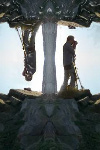
Cantabrian Holm Oak Forest: Some Relics.
Pimiango, Oriente de Asturias, Spain
August 25, 2011, 12:52 local time
© 2011 Iñaki Rezola, All Rights Reserved.
Cantabrian oaks grow in the limestone crags along the coast of the Basque Country, Cantabria and eastern Asturias, where the exposed, bare sloppy rocks make it impossible for soil to form. Holm oaks survive by spreading their roots into the limestone rock's cracks.
Irish strawberry trees, hollies and laurels grow in the damp soil of well developed Cantabrian oak forests, whilst, in sunny spots, laburnum, Mediterranean buckthorn, viburnum, Colchicum lusitanum (or Portuguese lilies), Butcher’s broom (or knee holly as it’s sometimes called), and evergreen roses make their appearance. These are typical climbing plants, such as black bryony, or blackeye root, clematis, honeysuckle and especially sarsaparille, which entangle the shrubbery to the point of converting the wood an almost impenetrable barrier for humans. Berries and acorns attract wild boar, jays and even common blackbirds. Genets love this habitat, far from human beings. Reptiles are even happier in these woods; the aesculapian snake lives there, and rock lizards are particularly abundant.
Human intervention and livestock overgrazing have produced a withdrawal in Irish strawberry trees, and they've been replaced by brambles and other species of thorny bushes. In particularly degraded areas, crawling briars and broom run rife.
For centuries, their inaccessibility kept them safe. Then, the depletion of oak forests and the high energetic quality of oak wood turned them into domestic fuel. Today, the main threats to Cantabrian oaks forest are fires and limestone quarries.
The panorama was taken in a little clearing in the woods near Pindal Cave, a World Heritage site due to its wall paintings, which attract quite a lot of people. That accounts for the openness of this part of the wood.
Information from Bizkaia Media.
Lat: 43° 23' 50.32" N
Long: 5° 32' 56.79" W
Elevation: 33 mts
Precision is: Medium. Nearby, but not to the last decimal.
El encinar cantábrico ocupa los roquedos calcáreos de la costa del País Vasco, Cantabria y Asturias, en los que se dan unas condiciones climáticas y edáficas particularmente estrictas que tan sólo la encina y sus especies asociadas logran soportar. Se trata de enclaves en general expuestos al mediodía, en laderas de fuerte pendiente en las que el agua se infiltra con rapidez. La desnudez de la roca dificulta la formación de suelo. La encina logra sobrevivir expandiendo sus raíces por las fisuras de la caliza.
En los encinares cantábricos bien desarrollados crecen también madroños, acebos y laureles en los enclaves de suelo húmedo mientras en las solanas aparecen el labiérnago, el aladierno, el durillo, el brezo lusitano, el rusco y Rosa sempervirens. Son típicas plantas trepadoras tales como la nueza negra, la clemátide, la madreselva y en especial la zarzaparrilla. Enmarañan el estrato arbustivo haciendo el bosque impenetrable.
A pesar de tratarse de bosques de extensión reducida y de difícil acceso, su abundante producción de bayas y bellotas atraen a los jabalíes y arrendajos o al propio mirlo común. La jineta encuentra un hábitat acogedor, a salvo del ser humano. Mucho más aún los reptiles, a quienes las condiciones de vida de los encinares favorece sobremanera. Habita en ellos la culebra de Esculapio y es abundante la lagartija roquera.
La intervención humana y del ganado provoca la regresión de los madroñales, apareciendo entonces un espinar con zarzas. En áreas muy degradadas proliferan los brezos rastreros y el lastón.
La inaccesibilidad de estos roquedos dificultó durante siglos su aprovechamiento. El agotamiento de los robledales y la alta calidad energética de la madera de encina llevó a su uso como combustible doméstico. Pero hoy en día las principales amenazas que soporta el encinar cantábrico son los incendios y la extracción de roca caliza en canteras.
La fotografía fue hecha en las cercanías de la cueva del Pindal, Patrimonio de la Humanidad debido a sus pinturas murales. Esto atrae a bastante gente y explica lo abierto del bosque en esta zona.
Información tomada de:
http://www.bizkaia.net/nekazaritza/gorbeia/mazizoa/ec-encinar.asp?Idioma=CA&Tem_codigo=2909
Kantauri aldeko artadiek EuskalHerria, Kantabria eta ekialdeko Asturiasen kostaldeetako kareharrizko haitzetan ugari aurki dezakegu. Bertako baldintza klimatikoak eta edafikoak hain dira zorrotzak, ezen arteak eta espezie kidetuek eutsi baitiezaiekete soilik. Normalean eguerdiko eguzkiaren pean dauden kokalekuak dira, malda gogorretan, ura azkar batean infiltratzen denekoak. Haitza soila izaten denez, nekez era daiteke bertan lurra. Erroak kareharriaren arrailetan barrena luzaturik erdiesten du arteak bizirik irautea.
Behar bezala garaturik dauden Kantauri aldeko artadietan gurbitzak, gorostiak eta ereinotzak ere hazi ohi dira, lurra hezea deneko tokietan eta eguteretan, berriz, gartxua, txorbeltza, gogortxua, erratza eta Rosa sempervirens delakoa aurkituko ditugu. Goraka hazten diren ohiko landareak izaten dira bertan apomahatsa, aihen zuria, atxaparra eta, bereziki, endalaharra. Zuhaixken geruza nahaspilatu egiten dute eta, ondorioz, ezinezkoa geratzen da basora sartzea.
Hedadura txikikoak eta bertara sartzeko zailak diren arren, baiak eta ezkurrak bertan ugari ekoizten direnez, erakarri egiten dituzte basurdeak ta eskinosoak, bai eta zozoa bera ere. Katajinetarentzako habitat atsegina gertatzen da, gizakietatik salbu. Are erakargarriagoa da narrastientzat: Eskulapioren sugea ere bizi da bertan, eta ugaria da haitzetako sugandila.
Gizakien eta aziendaren esku hartzearen ondorioz, atzeraka doaz gurbiztiak eta sasiak nagusitzen doaz toki horietan. Oso kaltetutako lekuetan ugariak dira txilar herrestaria eta albitz-belarra. Haitz horietara heltzerik ez zegoenez, bertatik probetxua ateratzea ere ezinezkoa izan zen mendetan eta mendetan.
Hariztiak agortu izanak, arteak erregai bihurtu zituen. Gaur egun, ordea, Kantauri aldeko artadiak jasaten dituen mehatxu nagusiak suteak eta harrobietako kareharriaren erauzketa dira.
Argazkia Pindal haitzuloaren inguru aterata dago. Paretetako margoak direla eta Gizadiaren Ondarea direnez, jende dexente hurbiltzen da paraje hauetara basoa irekiagoa egiten.
Informazio-iturria:
http://www.bizkaia.net/nekazaritza/gorbeia/mazizoa/ec-encinar.asp?Idioma=EU&Tem_codigo=2909


 Tap or click the zoom icon in the bottom right corner of the picture to switch between in-page and fullscreen view
Tap or click the zoom icon in the bottom right corner of the picture to switch between in-page and fullscreen view